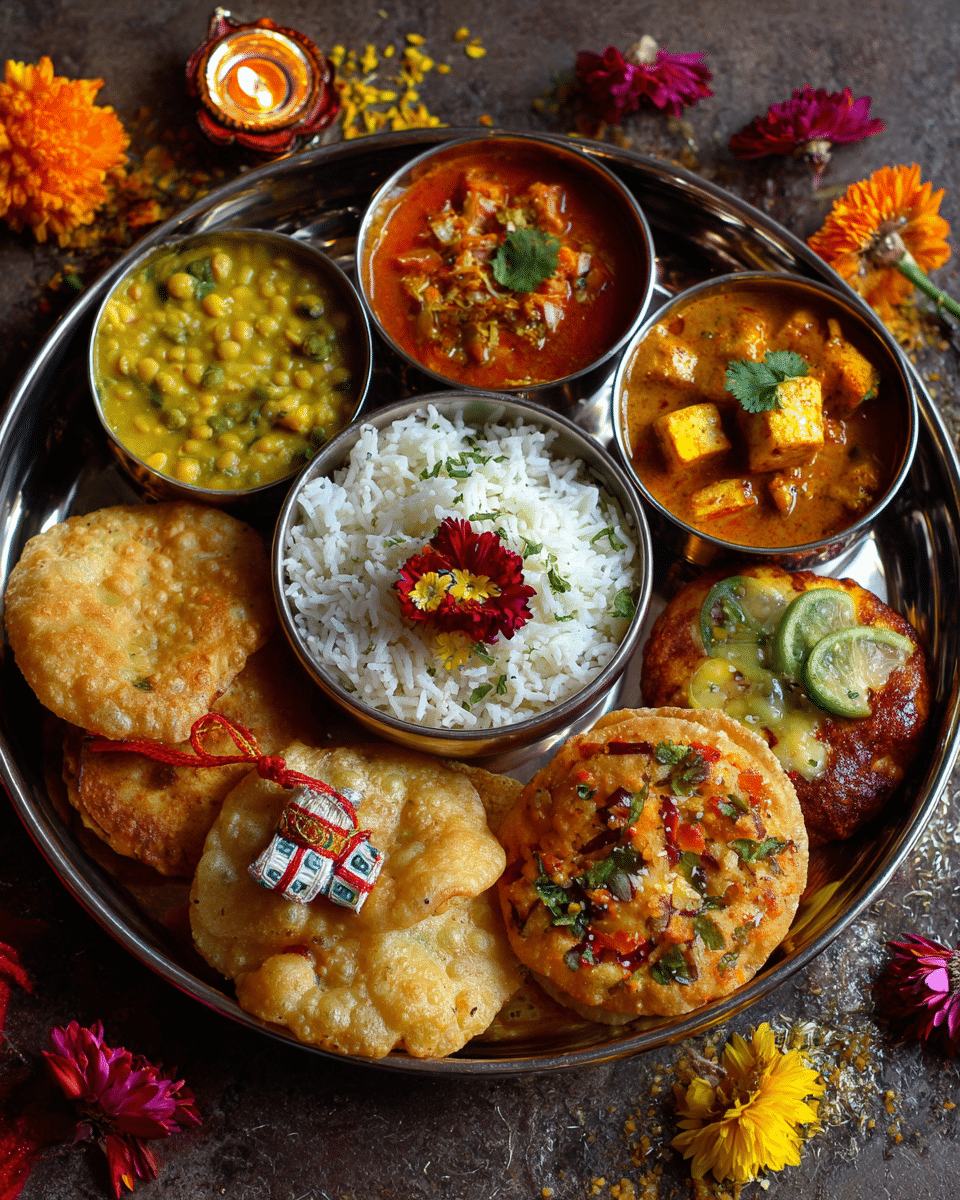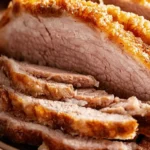The Traditional Rakhi Thali Platter is a sacred and celebratory assortment of dishes prepared during Raksha Bandhan, a festival that honors the bond between brothers and sisters. The platter is not just a meal—it’s a heartfelt expression of love, blessings, and cultural richness. This thali typically includes a variety of sweet, savory, and symbolic items such as puris, sabzi, rice, dal, sweets, and condiments, all beautifully arranged and offered after the Rakhi tying ceremony.
FULL RECIPE
Ingredients
- 1 cup basmati rice
- 1/2 cup chana dal (Bengal gram lentils)
- 1 cup mixed vegetables (carrot, beans, peas, potatoes)
- 1 teaspoon cumin seeds
- 1/2 teaspoon turmeric powder
- 1/2 teaspoon red chili powder
- 1 teaspoon garam masala
- 1 teaspoon ghee or clarified butter
- 1 tablespoon oil
- Salt to taste
- 2 cups wheat flour for puris
- Water and oil for kneading and frying puris
- 1 cup paneer cubes (for paneer curry)
- 2 tomatoes, finely chopped
- 1 onion, finely chopped
- 1 teaspoon ginger-garlic paste
- 1/2 cup fresh cream or yogurt
- 1 tablespoon butter
- 1/2 teaspoon kasuri methi (dried fenugreek leaves)
- 2–3 pieces of sweets like gulab jamun or ladoo
- Fresh coriander for garnish
- Pickle and papad (optional, for accompaniment)
Directions
- Cook Rice: Rinse basmati rice and cook in 2 cups of water until fluffy. Set aside.
- Prepare Chana Dal: Soak dal for 30 minutes. Pressure cook with salt and turmeric for 3 whistles. Temper with ghee, cumin seeds, and red chili powder.
- Make Mixed Veg Sabzi: In a pan, heat oil, add cumin seeds, chopped vegetables, salt, turmeric, and garam masala. Cover and cook until tender.
- Prepare Paneer Curry: Sauté onion in butter, add ginger-garlic paste, then tomatoes. Cook until mushy. Add spices and paneer cubes. Stir in cream and kasuri methi. Simmer for 5 minutes.
- Make Puris: Knead flour with water into a firm dough. Divide into balls, roll out, and deep fry until golden and puffed.
- Assemble Thali: Arrange rice, dal, puris, sabzi, paneer curry, pickle, and papad neatly on a thali. Add sweets in a small bowl or banana leaf to the side.
- Garnish and Serve: Garnish dishes with coriander and serve warm as a complete festive meal.
Nutrition Facts
- Calories: 740
- Total Fat: 28g
- Saturated Fat: 9g
- Cholesterol: 35mg
- Sodium: 580mg
- Total Carbohydrates: 96g
- Dietary Fiber: 9g
- Sugars: 8g
- Protein: 20g
- Calcium: 220mg
- Iron: 5.2mg
Cultural Significance of the Rakhi Thali
The Traditional Rakhi Thali Platter is far more than a meal—it is a symbolic tribute to the sacred bond between brothers and sisters in Indian culture. Presented after the Raksha Bandhan tying ceremony, the thali often includes both spiritual elements (like roli, rice, diya, and sweets) and a celebratory meal. It reflects the love, warmth, and gratitude between siblings, as sisters express blessings and brothers vow protection. The food on the thali becomes part of the celebration, deepening familial ties and evoking a sense of togetherness and cultural continuity.
Nutritional Balance of the Platter
A well-prepared Rakhi Thali offers a nutritionally balanced meal, with a diverse range of macro- and micronutrients. From the complex carbohydrates in rice and puris to the proteins in lentils and paneer, and the fiber in mixed vegetables, the platter delivers both satisfaction and sustenance. The use of ghee, yogurt, and spices like turmeric and cumin also adds to its digestibility and health benefits. When eaten in moderation, the thali provides a wholesome array of essential nutrients that nourish both the body and soul during this festive occasion.
Customizable Components for Every Palate
One of the joys of the Rakhi Thali is its flexibility. While traditional dishes like dal, sabzi, puris, and sweets are common, each family customizes the platter based on regional, religious, or personal preferences. North Indian versions might include chole or paneer butter masala, while South Indian thalis may offer lemon rice, coconut chutney, or rasam. Jain or vegetarian households may skip onions and garlic, replacing them with satvik alternatives. This adaptability makes the platter inclusive and widely loved across diverse communities.
Importance of Sweets in Rakhi Traditions
Sweets are a central component of the Rakhi celebration and thali. They symbolize the joy of the occasion and the hope for a sweet and prosperous future. Whether it’s gulab jamun, laddoo, peda, or barfi, the sweet dish on the thali is often handmade and offered first after the Rakhi is tied. The choice of sweet often holds sentimental value, such as a brother’s childhood favorite or a mother’s special recipe. Including sweets in the thali is an emotional and traditional gesture of affection and goodwill.
Spices and Aromatics: Flavor and Health
The spices used in a Rakhi Thali—turmeric, cumin, garam masala, and fenugreek—are more than just flavor enhancers; they have significant health-promoting properties. Turmeric is known for its anti-inflammatory effects, while cumin aids digestion and boosts immunity. Garam masala provides warmth and depth, while kasuri methi lends a unique earthy aroma to paneer dishes. These spices are used with care to ensure that the festive meal is not only aromatic and delicious but also comforting and nourishing.
Presentation Tips for a Traditional Feel
The visual presentation of the Rakhi Thali adds to its ceremonial charm. Traditionally, the dishes are arranged on a round metal thali with small bowls (katoris), each holding a different dish. Garnishing with fresh coriander, a drizzle of ghee, or a sprinkle of chopped nuts enhances visual appeal. Decorative banana leaves or brassware can lend a rustic, festive look. Adding symbolic items like a diya (lamp), incense, and a small bowl of rice or kumkum completes the spiritual and aesthetic elements of the presentation.
Side Accompaniments and Pairings
Accompaniments like papad, achar (pickle), and a simple raita can elevate the Rakhi Thali experience. A cooling cucumber raita or mint-flavored yogurt adds contrast to the rich curries and fried puris. Crunchy papads offer textural variation, while spicy mango or lime pickle provides a burst of tanginess. For beverages, a glass of lassi, rose sherbet, or spiced buttermilk makes an ideal pairing, helping to balance the flavors while keeping the meal refreshing and satisfying.
Tips for Preparing the Thali in Advance
Preparing a Rakhi Thali can be time-consuming, especially with multiple components. However, many elements can be prepped ahead. Chana dal and rice can be cooked and refrigerated, while puri dough can be prepared a few hours in advance. Curries like paneer or mixed veg sabzi often taste better after resting, allowing flavors to develop. Sweets can be made the day before and stored at room temperature. Efficient planning ensures a smooth and stress-free celebration with ample time for rituals and bonding.
Festive Variations and Regional Twists
Every region in India has its own festive thali variation for Raksha Bandhan. In Maharashtra, shrikhand may be featured as a dessert, while in Gujarat, dhokla or thepla might appear. In West Bengal, you might find cholar dal and mishti doi. South Indian thalis could include tamarind rice or coconut chutney. These regional variations highlight the diversity and richness of Indian cuisine while preserving the spirit of the Rakhi celebration. Families often blend their heritage with modern preferences to create personalized thalis.
Advertisement
Making It Vegan or Gluten-Free
For those with dietary restrictions, the Rakhi Thali can be easily modified. To make it vegan, substitute dairy-based ghee and paneer with plant-based alternatives like vegan butter or tofu. Use almond or coconut yogurt for creamy gravies and raita. For a gluten-free version, replace puris with gluten-free flatbreads or millet rotis. Many components, like rice, dal, and vegetables, are naturally gluten-free. These adjustments ensure that everyone at the table can participate fully in the festive meal without compromising on taste or tradition.
Conclusion
The Traditional Rakhi Thali Platter is a meaningful blend of food, family, and festivity. It encapsulates love, respect, and tradition through its carefully curated dishes and ceremonial presentation. Whether you stay true to ancestral recipes or adapt the platter to modern tastes and dietary needs, its essence remains the same—a celebration of sibling bonds through shared meals.






